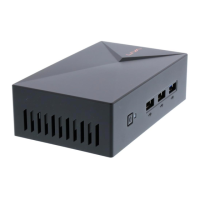
Do you have a question about the ECS LIVA X and is the answer not in the manual?
| Processor family | - |
|---|---|
| Processor frequency | - GHz |
| Internal memory | 4 GB |
| Internal memory type | DDR3L-SDRAM |
| Storage media | eMMC |
| Optical drive type | No |
| Total storage capacity | - GB |
| Discrete graphics card model | Not available |
| Ethernet LAN | Yes |
| Wi-Fi standards | 802.11b, 802.11g, Wi-Fi 4 (802.11n) |
| Cabling technology | 10/100/1000Base-T(X) |
| Top Wi-Fi standard | Wi-Fi 4 (802.11n) |
| Ethernet LAN data rates | 10, 100, 1000 Mbit/s |
| Audio chip | Realtek ALC283 |
| Product type | Mini PC |
| USB 2.0 ports quantity | 2 |
| USB 3.2 Gen 1 (3.1 Gen 1) Type-A ports quantity | 1 |
| USB 3.2 Gen 1 (3.1 Gen 1) Type-C ports quantity | 0 |
| Chassis type | Small Desktop |
| Product color | Black |
| Placement supported | Horizontal/Vertical |
| Panel mounting interface | 75 x 75, 100 x 100 mm |
| Power supply input voltage | 100-240 V |
| Depth | 83 mm |
|---|---|
| Width | 135 mm |
| Height | 40 mm |
| Weight | - g |
Information about publication rights and restrictions, including protection under international copyright laws.
States that the document is subject to change without notice and disclaims warranties for merchantability or fitness.
Lists registered trademarks of Microsoft, MS-DOS, Windows, and Intel Corporation.
Welcomes the user and introduces the LIVA X Mini PC, highlighting its performance and design.
Details the technical specifications of the PC, including CPU/Chipset, Memory, Expansion Slots, and Storage.
Identifies and describes the function of the front and rear input/output ports on the PC.
Illustrates and lists the key components located on the motherboard.
Explains the pin definitions for the UART_DBG and BT (Battery) headers.
Explains the BIOS Setup Utility, its purpose, and how it configures system parameters.
Discusses the standard configuration and when it is recommended to use the Setup Utility.
Guides on how to access the BIOS Setup Utility by pressing the DEL key during POST.
Explains how to reset CMOS values to factory defaults if a 'CMOS Settings Wrong' message appears.
Provides general instructions on navigating the BIOS menus and changing option values.
Lists the keyboard keys used for navigating and interacting within the BIOS setup utility.
Describes the main menu of the BIOS setup utility, showing basic system information.
Details the options available in the Advanced BIOS menu for CPU and system settings.
Configures system power management settings like Resume by PME, USB, and RTC Alarm.
Allows configuration of the PCI Express slot speed.
Configures the ACPI sleep state, specifically 'Suspend to RAM'.
Displays and allows configuration of CPU-related settings and information.
Shows detailed information about the CPU, including signature, cache, and speed.
Configures SATA mode (AHCI) and settings for mSATA devices.
Manages USB device support, including legacy USB and XHCI mode.
Allows configuration of SoC chip settings and TXE information.
Enables setting the CPU clock speed, CPU ratio, and memory frequency.
Configures boot order, boot mode, and boot priorities.
Allows setting up administrator and user passwords and secure boot options.
Provides options for saving changes, discarding changes, and exiting the BIOS setup.
Provides steps for downloading and installing updated BIOS from the manufacturer's website.
Guides on installing Windows OS via an official DVD or a USB flash drive.
Explains the automatic installation of drivers and software from the support DVD-ROM.
Step-by-step instructions for initiating and proceeding with the driver installation program.
Describes how to manually install drivers using the file manager if auto-install fails.
Provides instructions from Microsoft for refreshing or resetting the PC.
Detailed steps for resetting the PC, warning about data loss and settings reset.
Guide on using System Restore to revert the PC to a previous state.
Solutions for boot failures, black screen, and display errors.
Troubleshooting for LAN, Wireless connectivity, and audio problems.
